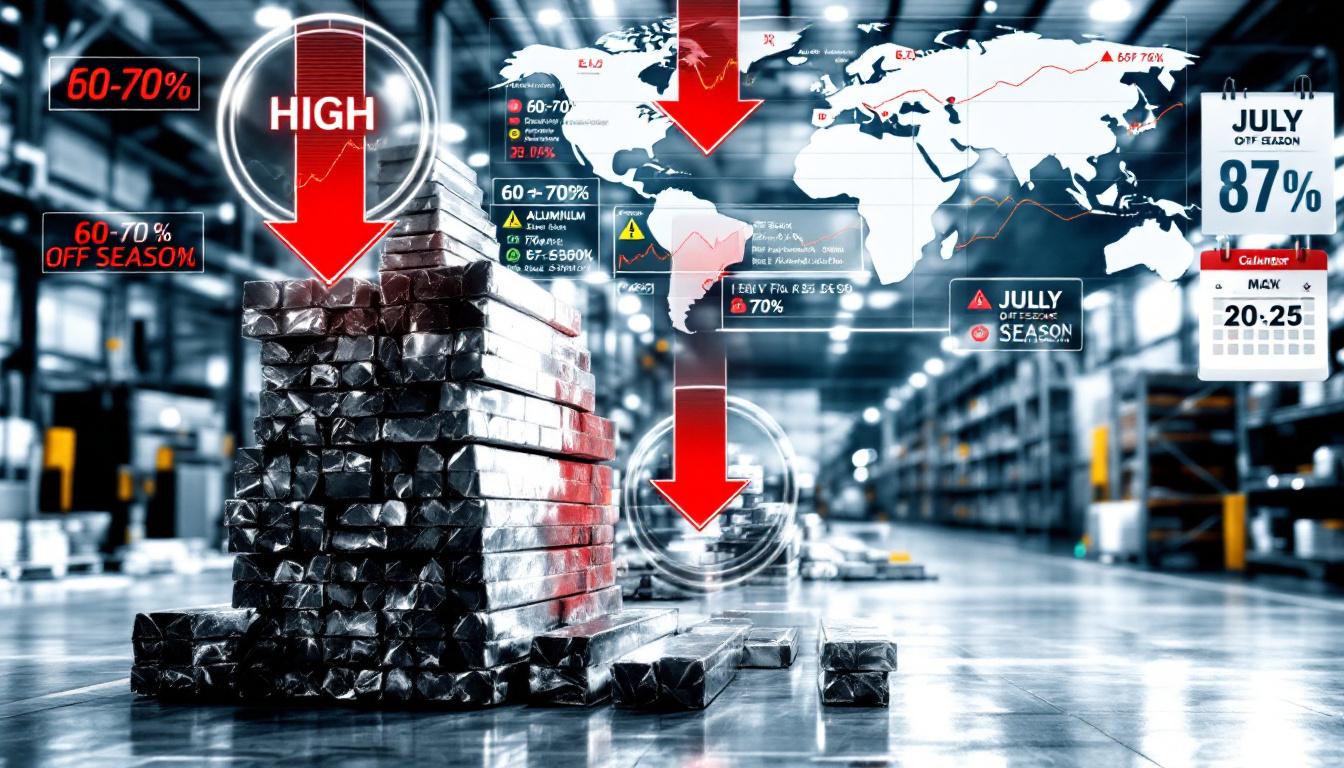Understanding How OPEC+ Output Hikes Impact Oil Prices
The recent decision by OPEC+ to increase oil production by 411,000 barrels per day (bpd) has sent ripples through global energy markets, creating significant downward pressure on prices. This strategic move represents a fundamental shift in the group's approach to market management, moving away from price support through supply constraints toward reclaiming market share from non-member producers.
According to real-time data, WTI crude is trading around $65.98 per barrel (down 0.78%), while Brent crude hovers at approximately $67.78 (down 0.76%). These price levels reflect growing concerns about potential oversupply conditions developing in the latter half of 2025, despite ongoing geopolitical tensions that would typically support higher prices.
Ole Hansen, Head of Commodity Strategy at Saxo Bank, explains the reasoning behind the surprise increase: "OPEC+ continues to ramp up production in an effort to punish overproducing quota cheaters, and to reclaim market share from higher-cost producers." This dual motivation – disciplining members while challenging competitors – highlights the complex strategic calculations driving OPEC+ decision-making.
Industry analysts note that while the headline increase is 411,000 bpd, the actual additional volume reaching markets will likely be between 250,000-300,000 bpd due to production capacity constraints among some member countries. Even this reduced volume appears sufficient to maintain downward pressure on prices through the traditionally high-demand summer season.
Key insight: OPEC+'s willingness to increase production despite falling prices signals a strategic pivot from price defense to market share protection – a fundamental shift in the group's approach to oil market management.
What is OPEC+ and How Does it Influence Global Oil Markets?
The Evolution of OPEC to OPEC+
The Organization of Petroleum Exporting Countries (OPEC) was founded in 1960 by Iran, Iraq, Kuwait, Saudi Arabia, and Venezuela with the aim of coordinating petroleum policies among member countries. Over decades, its membership expanded to include nations across the Middle East, Africa, and South America.
OPEC+ emerged in 2016 when OPEC formed a strategic alliance with Russia and several other non-OPEC producers. This expanded coalition now controls approximately 40% of global oil production and holds about 80% of the world's proven oil reserves, according to the International Energy Agency's 2024 Oil Market Report.
This massive share of global production and reserves gives OPEC+ unprecedented influence over global energy markets. When the alliance announces production changes, markets typically respond immediately as traders adjust positions based on anticipated supply shifts.
The Mechanics of Production Quotas
OPEC+ employs a sophisticated quota system that allocates specific production targets to each member country. These quotas are determined through complex negotiations that consider various factors:
- Historical production capacity
- Current technical production capabilities
- Economic needs and fiscal breakeven prices
- Political considerations and regional influence
- Reserve-to-production ratios
Compliance with these quotas varies significantly across the membership. Saudi Arabia frequently serves as the "swing producer," adjusting its output to compensate for others' overproduction or to respond to market conditions. Kazakhstan, for instance, recently reported record-high oil production of 2.02 million bpd in June 2025, exceeding its OPEC+ quota and creating internal tensions within the alliance.
The effectiveness of the quota system depends heavily on members' willingness to adhere to their allocations. When compliance weakens, as it has recently among several members, the alliance often employs various enforcement mechanisms – including the current strategy of increasing overall production to pressure overproducers by reducing their profit margins.
Why Did OPEC+ Announce a Surprise Output Increase?
Market Share Concerns
A primary motivation behind the OPEC+ production increase is the group's declining market share. According to the U.S. Energy Information Administration's latest data, OPEC+'s share of global oil production has slipped by approximately 1.8 percentage points over the past 18 months, primarily due to growth from U.S. shale, Brazilian offshore fields, and Canadian oil sands.
"This production increase represents a clear shift in OPEC+ strategy from price defense to market share protection," notes Rob Thummel of Tortoise Capital. "The group appears willing to accept modestly lower prices to discourage investment in higher-cost production regions."
The strategy targets competing producers with higher breakeven costs:
- U.S. shale: $45-55/bbl breakeven (varying by basin)
- Canadian oil sands: $50-60/bbl breakeven
- Brazil pre-salt: $35-45/bbl breakeven
- North Sea: $50-65/bbl breakeven
By keeping prices in the mid-$60s range, OPEC+ aims to create an environment where capital expenditure for these competing regions becomes less attractive, potentially slowing their production growth over time.
Punishing Quota Violations
Internal discipline represents another key motivation for the production increase. Several OPEC+ members have consistently exceeded their quotas, with Kazakhstan being the most prominent recent example.
According to data from the OPEC Secretariat, the following members exceeded their May 2025 quotas:
- Kazakhstan: +320,000 bpd
- Iraq: +220,000 bpd
- Russia: +190,000 bpd
- UAE: +150,000 bpd
By increasing overall output, OPEC+ creates market conditions that reduce the profitability of this overproduction, essentially using market forces rather than diplomatic pressure to enforce compliance.
Responding to Seasonal Demand Patterns
The timing of the production increase aligns with typical seasonal demand patterns. Northern Hemisphere summer typically sees petroleum demand increase by 1.2-1.5 million bpd compared to winter months, according to five-year average data from the IEA.
"OPEC+ is timing this increase to coincide with peak seasonal demand," explains Matthew Sherwood, analyst at the Economist Intelligence Unit (EIU). "This allows them to increase market share while minimizing price impact during a period of naturally higher consumption."
This strategic timing demonstrates OPEC+'s sophisticated understanding of market cycles and its ability to leverage seasonal patterns to achieve multiple objectives simultaneously.
How Are Current Oil Prices Responding to the OPEC+ Decision?
Immediate Market Reaction
The market response to OPEC+'s production increase has been decidedly bearish. As of the latest trading session, oil prices ease under tariffs across all major benchmarks:
| Benchmark | Price (USD) | Change (%) |
|---|---|---|
| WTI Crude | $65.98 | -0.78% |
| Brent Crude | $67.78 | -0.76% |
| Murban Crude | $68.78 | -1.25% |
| Gasoline Futures | $2.10 | -0.60% |
The steeper decline in Murban crude (-1.25%) compared to other benchmarks signals particular pressure in Asian markets, which are most directly affected by OPEC+ supply increases. This differential suggests Asian refiners may be anticipating growing supply availability in their region, putting additional downward pressure on regional crude grades.
Price Trends and Technical Analysis
Current price levels represent a significant departure from the $70+ per barrel range that many analysts, including Rob Thummel of Tortoise Capital, consider the "normal" equilibrium price in a balanced market. Technical indicators suggest:
- Resistance levels: $70 for WTI and $72 for Brent
- Support levels: $63-$64 for WTI and $65-$66 for Brent
- Moving averages: Prices currently trading below the 50-day moving average but above the 200-day moving average, indicating a short-term bearish trend within a longer-term neutral pattern
Market positioning data from the CFTC shows managed money reducing net long positions for four consecutive weeks, reflecting growing pessimism about near-term price prospects among speculative traders. This technical positioning aligns with fundamentals suggesting continued supply growth outpacing demand increases.
Regional Price Differentials
Regional price spreads provide valuable insight into localized supply-demand dynamics:
- The Brent-WTI spread currently stands at approximately $1.80 per barrel, indicating relatively balanced Atlantic Basin and North American markets.
- The wider Brent-Dubai spread ($4.25) suggests more acute oversupply conditions in Asian markets.
- Backwardation (prompt prices higher than futures) in the Brent curve has narrowed to just $0.20 between front-month and second-month contracts, indicating weakening market tightness.
These spread relationships reflect market expectations that the OPEC+ production increase will primarily impact Asian markets first, with effects gradually spreading to other regions as increased volumes work through the global supply chain.
What Factors Are Keeping Oil Prices Below $70 Despite Geopolitical Tensions?
Supply Fundamentals Overshadowing Geopolitical Risk
Despite significant ongoing conflicts in the Middle East, oil prices remain subdued primarily due to robust global supply fundamentals. Market analysts emphasize that the oil market has fundamentally changed its response to geopolitical tensions.
"Unless actual supply disruptions occur in and around the hotspots in the Middle East, the price of oil will be a function of supply and demand," notes Ole Hansen of Saxo Bank. This represents a significant shift from historical patterns where geopolitical tensions would typically trigger substantial risk premiums in oil prices.
Recent events underscore this changed dynamic:
- July 3rd U.S. sanctions targeting Iran's oil-smuggling network failed to lift prices
- Ongoing Israel-Hezbollah border conflicts have had minimal price impact
- Libyan pipeline leak resolution on July 3rd prevented supply disruption concerns
- Repeated Houthi attacks on shipping in the Red Sea now barely register in daily price movements
This muted response to geopolitical events reflects the market's assessment that current global spare capacity is sufficient to offset potential disruptions.
Economic Uncertainty and Demand Concerns
Global economic indicators present a mixed picture for petroleum demand growth, creating significant uncertainty in forward consumption projections. Particular concern centers around trade war impact on oil markets and their potential impact on global economic activity.
ING strategists highlight that "uncertainty related to potential new tariffs following the expiration of a 90-day pause on 'reciprocal' tariffs on July 9th creates significant downside risks for petroleum demand." These potential tariffs could disrupt global supply chains and economic growth, particularly affecting China and broader Asian demand.
Additional demand concerns include:
- European economic stagnation limiting consumption growth
- Emerging market currency pressures affecting purchasing power
- Electric vehicle adoption accelerating in key markets
- Post-pandemic structural changes in commuting and travel patterns
These combined demand uncertainties create a significant counterbalance to supply disruption risks from regional conflicts.
Strategic Petroleum Reserve Dynamics
Strategic petroleum reserves (SPRs) in major consuming nations represent a significant buffer against supply disruptions, further limiting the market impact of geopolitical tensions. According to a recent report from Forbes, OECD nations collectively hold approximately 1.8 billion barrels in strategic reserves, equivalent to 38 days of total demand.
The U.S. Strategic Petroleum Reserve, despite recent releases, still contains over 360 million barrels – sufficient to offset major supply disruptions. More importantly, consuming nations have demonstrated increased willingness to coordinate reserve releases to counter price spikes.
Market psychology insight: The mere existence of substantial strategic reserves, combined with demonstrated political will to use them, creates a psychological ceiling on prices despite geopolitical tensions. Traders factor this intervention potential into their risk calculations, limiting speculative upside during crises.
How Are Investment Banks Forecasting Oil Prices for the Remainder of 2025?
Consensus Price Projections
Major financial institutions have converged on surprisingly similar oil price forecasts for 2025, suggesting broad agreement on market fundamentals. According to the most recent Wall Street Journal survey (June 2025), investment banks including Goldman Sachs, Morgan Stanley, and JPMorgan project:
- Brent crude: Average of $66.32 per barrel for 2025
- WTI crude: Average of $63.03 per barrel for 2025
These projections represent modest increases from earlier forecasts but still indicate expectations of prices remaining below the $70 threshold that many analysts consider the equilibrium price in a balanced market.
A separate Reuters survey of 34 economists and analysts (June 30, 2025) yielded slightly higher average forecasts of $67.86 for Brent and $64.51 for WTI, still within a similar range to the Wall Street Journal survey.
Supply-Demand Balance Analysis
Investment bank analyses consistently identify market oversupply as the primary price-limiting factor. Goldman Sachs' commodity research team estimates the current global supply surplus at approximately 800,000 bpd, with this surplus expected to persist through the third quarter despite strong summer demand.
The OPEC+ increase of 411,000 bpd, while not fully realizable due to capacity constraints among some members, will add sufficient additional barrels to maintain the current supply surplus through autumn. JPMorgan analysts estimate that effective additional supply reaching markets will be between 250,000-300,000 bpd from the announced increase.
Morgan Stanley's commodity team specifically cites three factors maintaining the supply surplus:
- Higher-than-expected Russian exports despite sanctions
- Recovered Libyan production following earlier disruptions
- Brazilian offshore production growth exceeding expectations
These supply factors are expected to outweigh potential demand growth even during peak summer consumption.
Scenario-Based Forecasting
Financial analysts have developed multiple price scenarios based on different market conditions, reflecting the unusual degree of uncertainty in current oil markets.
Base Case Scenario (60-70% probability):
- Prices remain in mid-$60s range
- Continued OPEC+ overproduction
- Modest global economic growth
- No major supply disruptions
Downside Scenario (20-25% probability):
- Prices drop to upper $50s
- Demand weakens due to economic slowdown
- OPEC+ compliance deteriorates further
- Trade war oil movements intensify
Upside Scenario (10-15% probability):
- Prices consistently above $70
- Actual physical supply disruptions occur
- Stronger-than-expected demand
- OPEC+ reverses course with production cuts
This scenario-based approach highlights the contingent nature of current price forecasts and the key variables that could alter the market trajectory.
What Options Does OPEC+ Have If Prices Fall Further?
Production Cut Mechanisms
OPEC+ maintains several mechanisms to implement production cuts if prices fall significantly below acceptable levels. According to Matthew Sherwood of the Economist Intelligence Unit, "OPEC+ is likely to act swiftly to put a floor under prices by pausing production increases" if market conditions deteriorate.
Most analysts believe the intervention threshold is around $60 per barrel – the approximate fiscal breakeven price for many OPEC members, particularly Saudi Arabia. Below this level, budget pressures would likely trigger coordinated action to support prices.
The alliance's options include:
- Immediate reversal of recent production increases
- Emergency ministerial meeting to signal market concern
- Voluntary cuts from key members (particularly Saudi Arabia)
- Collective production cuts across all members
Historical precedent suggests OPEC+ typically responds within 1-2 months of sustained price weakness, with Saudi Arabia often taking preemptive unilateral action before broader group consensus emerges.
Selective Compliance Enforcement
Rather than implementing across-the-board cuts, OPEC+ could increase pressure on overproducing members to adhere to quotas. This targeted approach would reduce overall supply while maintaining the principle that all members must respect production agreements.
Current overproduction by Kazakhstan, Iraq, Russia, and the UAE amounts to approximately 880,000 bpd above their collective quotas. Simply enforcing existing agreements could eliminate a substantial portion of the current market surplus without requiring new policy decisions.
The group has various enforcement mechanisms available:
- Public naming and quotas-shaming of overproducers
- Requiring "compensation cuts" for past overproduction
- Adjusting baseline production levels for chronic overproducers
- Forming monitoring committees to track compliance
This nuanced approach would allow OPEC+ to address both price and internal cohesion concerns simultaneously.
Strategic Communication and Signaling
OPEC+ has refined its market communication strategy over decades, effectively using public statements and meeting announcements to signal future intentions. If prices weaken substantially, the group could employ several signaling techniques:
- Scheduling an emergency meeting (even without immediate action)
- Public statements from key ministers expressing price concerns
- Leaking potential production strategies to media outlets
- Announcing technical committee reviews of market conditions
These communication tactics often influence market psychology before any actual production changes, allowing OPEC+ to test market response before committing to policy shifts.
Expert insight: "OPEC+ has mastered the art of jawboning markets," explains energy analyst Matthew Sherwood. "Their statements often move prices as effectively as actual production changes, giving them significant influence even when policy remains unchanged."
How Are Non-OPEC+ Producers Responding to
Ready to Stay Ahead of Major Market Shifts in the Oil Sector?
Stay informed about critical developments like OPEC+ decisions and their impact on oil markets with Discovery Alert's proprietary Discovery IQ model, delivering real-time insights on significant market-moving events across all key commodities. Visit our discoveries page to understand how timely alerts can provide you with actionable investment advantages.




